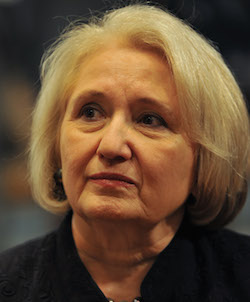
Changing Perceptions for Women’s Future
Alejandra Aponte | March 10, 2015
Responding To: Week 7: Gender Issues
Kailee Jordan
Last week Katherine Marshall discussed the rise of extremism, arguing for a deeper exploration of the links between poverty and violence. This is welcome. We need to highlight the complexities between oppression and violence if we are to create a more just world. In the debate on extremism, violence and solutions for change, one critical piece is being left out of the discussion: the importance of women and girls in laying the foundation for peaceful communities.
Evidence on the impact of conflict on women is overwhelming. You don’t have to look far to find stories of ISIS trafficking Yazidi women for sexual slavery, Boko Haram kidnapping schoolgirls, or on the brutal sexual violence being perpetrated in South Sudan. In most conflicts around the world, women and girls face disproportionate impacts, highlighting their social, economic, and political inequalities. Yet, while women are still presented as victims of conflict, rarely are they tapped as viable sources for post-conflict reconstruction. Too often, girls and women come across as passive recipients of oppression, but they are vital for resilient communities.
Nowhere is this clearer than when you look at women in formal peace-building efforts. UN Women reports that out of the 585 peace agreements from 1989 to 2010, only 16 percent contained any reference to women. [1] Since the early 1990’s, women’s participation in peace negotiations has only reached 9 percent, with women making up 4 percent of signatories and 2.4 percent of chief mediators [2]. Excluding women in peace processes also applies in post-conflict reconstruction efforts, with women and girls sidelined from funding allocations, justice mechanisms, and decision-making entities [3].
Women have, despite all the obstacles, demonstrated time and time again that they are an important element for sustainable peace. Take Leymah Gbowee for example, a peace activist who mobilized women across Liberia to press their government into ending the civil war. Or Irene Santiago, a lead negotiator in the Philippines, who formed nation-wide women’s peace tables to facilitate public participation in peace efforts. Wide ranging South Sudanese women’s organizations argue strenuously for an end to current recent conflict.
New evidence demonstrates that including women in peace-building efforts increases the probability of ending violence by 24 percent [4], and that inclusive peace processes are 64 percent less likely to fail than ones that just include political parties or armed actors [5]. With these kinds of dividends, we do society a great injustice by failing to include women in strategies for counteracting violence. You can’t have sustainable development without peaceful communities. And you can’t have peaceful communities when you leave out half of your population.
Kailee Jordan is a graduate student pursuing her Master’s in global affairs at the University of Toronto. Jordan has interned at UN Women in Tanzania and has worked with organizations such as International Volunteer Network and Burnaby Youth Custody Services.
[1] UN Women. (2014). ‘Facts and Figures: Peace and Security.’ UN Women. http://www.unwomen.org/en/what-we-do/peace-and-security/facts-and-figures
[2] Ibid.
[3] Ibid.
[4] Laurel Stone. (2014). ‘Can women make the world more peaceful?’ The Guardian. http://www.theguardian.com/global-development-professionals-network/2014/aug/11/women-conflict-peace-society?CMP=share_btn_fb
[5] Kristin Williams. (2014). ‘Women Peacebuilders reflect, connect, and act.’ Institute for Inclusive Security. http://www.inclusivesecurity.org/women-peacebuilders-reflect-connect-and-act-2/

Alejandra Aponte | March 10, 2015

Melanne Verveer | March 9, 2015

Susan Brooks Thistlethwaite | March 9, 2015

Tasmia Rahman | March 9, 2015